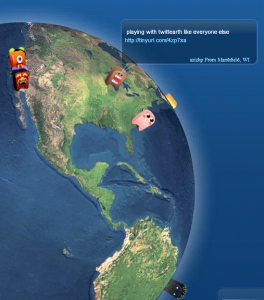In Neil Stephenson’s Snowcrash, the Metaverse appeared to its users as a single city strung along a road a hundred meters wide, spanning 200 km around the equator of an otherwise utterly featureless, black, spherical planet floating in electronic void.
TwitterEarth is cooler:
Plenty of others have reviewed Twittearth already (and plenty more have twitterred about it). But what strikes me about it the most, apart from the sheer novelty, is how in a way it really underscores the way that Twitter functions as a universe unto itself. This is Planet Twitter. It’s self-referential, a global conversation focused as often as not upon its own navel.
We aren’t used to thinking about the internet communities we inhabit in a geographical sense. Usually our friends and networks exist as linear scrolling boxes of text. Twittearth takes that line and turns it into a sphere, one we can relate to strongly and intuitively. There’s something utterly captivating about watching that globe spin and tiny avatars spout their profundities in 140 characters or less – it’s real, more tangible, in a way that can’t be felt through the browser window or client app.
There’s a lesson here that the internet tools we use and social networks we inhabit are very much artificial in their presentation. If someone figured out a way to represent, for example, Facebook as a virtual planet, with friends, photos, video, etc all rooted solidly in a where rather than a when. Imagine all social networks, Facebook and mySpace and Google’s Open Social alike, existing on the same world. I think we are further along the path to the metaverse than we realize.
And I have to admit I am very pleased that my avatar turned out to be Domo-kun.
